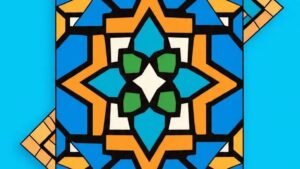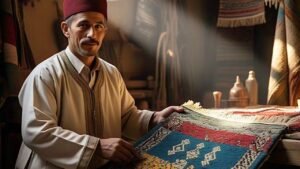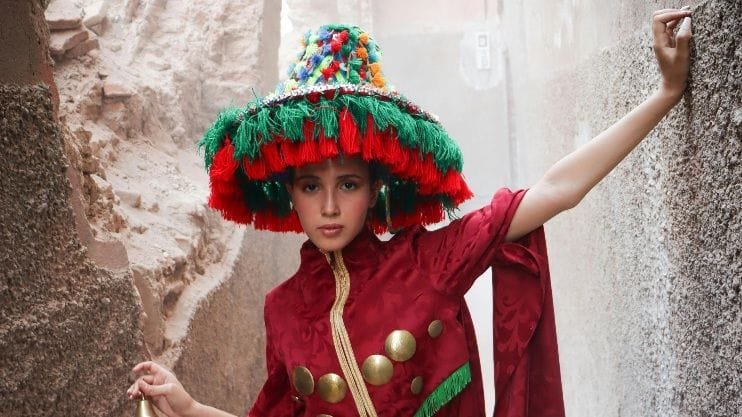
Imagine strolling through the bustling souks of Morocco, feeling the weight of centuries of tradition in every step. The vibrant stalls, filled with the scent of leather and the shine of intricate metalwork, are a testament to the enduring beauty of Moroccan handicrafts. Today, these timeless crafts are undergoing a renaissance, blending ancient techniques with modern sensibilities. For those eager to explore the captivating world of these artisans, the crossroads of tradition and innovation offers an unparalleled experience. Whether you’re a traveler searching for authentic cultural souvenirs or a foreign professional looking to collaborate with Moroccan artisans, the landscape of Moroccan handicrafts is more vibrant and accessible than ever before.
Modern Patterns and Colors: A Fresh Take on Tradition
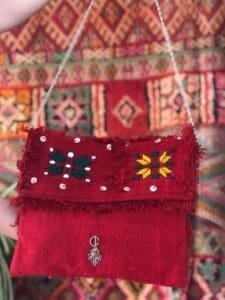
The most noticeable evolution in Moroccan handicrafts lies in the bold, modernized patterns and colors. Traditionally, Moroccan artisans were renowned for their geometric rug patterns, vibrant tilework, and intricately woven textiles. Today, however, young artisans are reimagining these centuries-old designs, incorporating them into a variety of contemporary products. Take the motifs of traditional Berber rugs, for instance. The geometric shapes, the intricate diamond forms, and the abstract patterns that once adorned the floors and walls of Moroccan homes are now appearing on modern apparel, handbags, and footwear. These patterns have transcended the realm of textiles, entering fashion and accessories in a way that blends tradition with a contemporary, global aesthetic.
In Morocco’s creative hubs like Marrakech and Fes, fashion designers and artisans are increasingly incorporating Berber rug patterns into clothing lines, such as dresses, jackets, and scarves, blending the cultural symbols with global trends. Moroccan leather bags, too, are featuring woven designs inspired by the iconic motifs found in ancient carpets, with bold colors that attract a young and fashion-forward crowd. The synergy between Moroccan traditions and modern design can also be seen in contemporary home decor, where tile patterns are now reimagined on furniture or on tabletops, creating a seamless fusion of the old and new.
Beyond rugs and textiles, these traditional patterns are being revived in innovative ways in pottery and ceramics, where artisans are combining the intricate geometric shapes with the use of new color techniques. This creative crossover is helping Moroccan artisans connect with international markets while staying grounded in their rich cultural heritage, offering the world a fresh perspective on Moroccan artistry.
Materials and Canvas: The Evolution of Moroccan Handicrafts
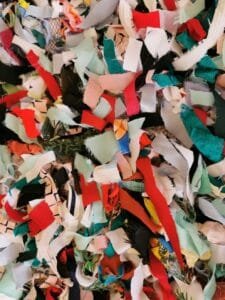
While the artistry of Moroccan handicrafts has remained rooted in tradition, the materials and techniques used have evolved significantly in recent years. For many artisans, the inclusion of some machines has become a practical necessity. Machines now help speed up certain stages of production, especially when it comes to repetitive tasks like weaving and dyeing. For example, in the creation of textiles, the use of computerized looms has allowed artisans to produce more intricate patterns more quickly, without sacrificing the authentic craftsmanship that is central to Moroccan culture. While these modern tools offer increased efficiency, artisans maintain a hands-on approach in the final stages, preserving the unique touch that defines Moroccan handicrafts.
Moreover, new technologies have empowered Moroccan artisans to draw inspiration from cultures far beyond their borders. For example, laser cutting technology allows artisans to carve intricate designs in wood, metal, and even leather with precision that was previously unimaginable. This technological leap, combined with traditional handcraft, has led to the creation of sophisticated new products like intricately detailed modern lanterns and contemporary furniture, all designed with an eye to the fusion of cultures.
In terms of materials, there has been a noticeable shift toward incorporating modern fabrics and sustainable alternatives. For example, the use of organic cotton and linen is becoming more common in the production of textiles, where artisans are blending these eco-friendly fibers with traditional wool. In the realm of ceramics, new glazing techniques have allowed artisans to experiment with vibrant, metallic finishes and even incorporate materials like glass and recycled metal. Meanwhile, in leatherwork, artisans are exploring alternative materials such as vegan leather and recycled textiles to meet the growing demand for ethically sourced products. These new canvases and materials allow for creative expression, while aligning with the global push toward sustainability.
New Ways to Sell and Promote: A Global Marketplace

In the age of digital connectivity, the ways in which Moroccan handicrafts are sold and promoted have also transformed. Traditionally, these crafts were sold in local souks, catering primarily to tourists and the local market. Today, Moroccan artisans are taking their work global, thanks to the rise of e-commerce and social media platforms. The advent of online marketplaces, coupled with a strong social media presence, has allowed artisans to showcase their work to a much wider, international audience.
Instagram has become a particularly powerful tool for Moroccan artisans, offering them a platform to share their stories, processes, and finished products with potential buyers from all over the world. Through visually rich posts and direct engagement with their followers, artisans can now build global brands from their workshops in the heart of Morocco. This shift to online selling has also opened up new possibilities for foreign professionals, offering a convenient way to source unique, handcrafted products that speak to both tradition and modernity.
Additionally, the online world has provided Moroccan artisans with the opportunity to collaborate with international designers, architects, and fashion brands. By partnering with global players, Moroccan craftsmanship is reaching new markets and being integrated into high-end designs. This expansion of Moroccan handicrafts into global supply chains is fostering a new generation of artisans who understand the business side of their craft, allowing them to grow and flourish in an increasingly interconnected world.
The Importance of Renovation in Moroccan handicrafts

While innovation and modern techniques are shaping the future of Moroccan handicrafts, the importance of renovation cannot be overstated. Renovation, in the context of Moroccan crafts, goes beyond merely updating designs or materials; it involves a deep respect for tradition, coupled with an understanding of the need to adapt and evolve. Renovating traditional crafts means ensuring that these age-old practices do not disappear but continue to thrive in the modern era.
This need for renovation is particularly pressing as Morocco faces the challenges of urbanization and the loss of younger generations interested in traditional crafts. To ensure that these crafts remain relevant, there must be a concerted effort to preserve their essence while making them more appealing to a global audience. For instance, artisans have started incorporating contemporary forms and functions into their work without losing the authenticity of their craft. This form of respectful renovation not only sustains the craft but also revitalizes it for future generations.
Moreover, institutions and businesses are beginning to recognize the value of supporting this renovation. Partnerships between Moroccan artisans and cultural organizations have paved the way for the documentation and preservation of traditional techniques, ensuring that the knowledge is passed down to future artisans. This collaborative effort between tradition and innovation is essential for the continued success of Moroccan handicrafts in the modern world.
The Future of Modern Moroccan Handicrafts
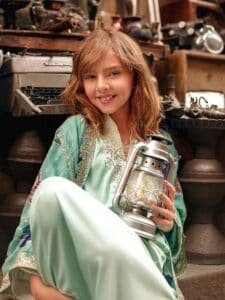
Looking ahead, the future of modern Moroccan handicrafts seems full of possibility. As these crafts continue to evolve, they are positioned to play an even more prominent role in global markets, thanks to their unique blend of tradition, craftsmanship, and modern innovation. The continued rise of ethical consumerism and the global appetite for handmade, sustainable goods provide the perfect backdrop for Moroccan artisans to thrive.
For foreign professionals looking to work with Moroccan artisans, the opportunities are vast. There is a growing market for collaborations in interior design, fashion, and the luxury goods sector, where Moroccan craftsmanship is increasingly sought after. As the world becomes more interconnected, Moroccan artisans have the chance to showcase their unique talents on the global stage, collaborating with international brands to create truly exceptional products.
Ultimately, the future of Moroccan handicrafts lies in the balance between preserving tradition and embracing modernity. As artisans continue to innovate while staying true to their roots, the world will continue to be captivated by the beauty and craftsmanship of Moroccan artistry, ensuring its place in both the present and the future.

